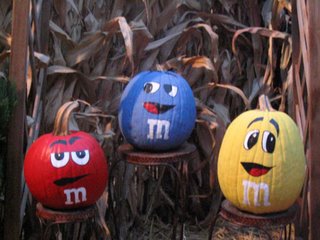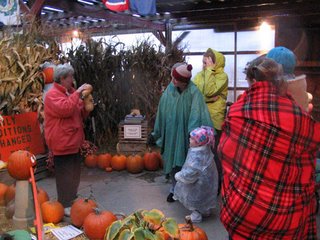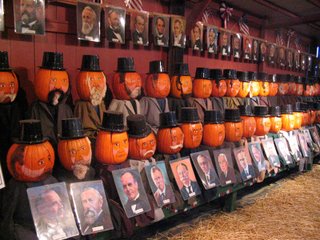
On Thursady evening, we rounded up everyone we could find (including a few MKs from the local Mu Kappa chapter; you get a discount with groups of 10 or more) and took a fun sidetrip to Fashion Farms' Pumpkin Fantasyland. No, I'm not making up the name. There are some things just too strange to make up.
The story of this place is that the founder, one day, picked up two butternut squash, held them together, and said, "Hey, that looks like Snoopy..." Our tour guide demonstrated:

The theme that year was Cute Commercial Characters. So there were things like the Pillsbury Doughboy...

...or the AFLAC Duck:

As well as a few things that are there every year, like portraits of all the U.S. presidents on pumpkins:

A lot of which were very well done. I asked our guide posed beside her own portrait:

There were other activities, as well, such as several mazes. Aiden trundled along with us in the wagon for most of these, and had a great time. This was in the large corn maze.
 The best maze, in my opinion, was the crawling maze—it was in a barn, made of hay bales, and it was pitch black inside. You had to work at it, not just guess. Paul and May followed the left edge, and Deborah and I followed the right, which ensured that we hit every dead end possible, but also got out OK.
The best maze, in my opinion, was the crawling maze—it was in a barn, made of hay bales, and it was pitch black inside. You had to work at it, not just guess. Paul and May followed the left edge, and Deborah and I followed the right, which ensured that we hit every dead end possible, but also got out OK.

3 comments:
Making a maze of hay bales is unusual, although straw is fairly common. Incidentally, it is entirely possible to construct a maze so that your follow-the-edge method doesn't work. The mericful way to do this is to leave the entrance normal, so that always following the edge will get you back out, only without solving the maze. It is also, however, possible to rig things so that following the edges will only lead you around in circles indefinitely.
You're right, they were straw bales. I hadn't known the difference until I looked up both just now. So why does no one ever refer to straw bales, then?
I would be interested in seeing some examples of mazes where left- or right-edge-following wouldn't work. Paul and I were discussing this the other day, and figured that it was probably possible as long as the entrance and exit were not along the outside edge. If both entrance and exit were along the perimiter, though, I can't construct a scenario where edge-following would fail.
Andy
> So why does no one ever refer to straw bales, then?
Huh? People refer to straw bales all the time. I daresay non-farmers typically refer to straw bales rather more often than hay bales, because they're much more frequently seen outside the context of an actual working farm. Indeed, I was in close proximity to a number of straw bales just this past Sunday evening, but, living in a city (albeit not a large one), I have not seen a single bale of hay in several years. Hay is pretty much just used to feed animals, but straw is used for many things. Its primary use of course is as bedding, but it's also popular as mulch, in home construction, in Christmas pageants, as generic stuffing (e.g., for scarecrows), and assorted recreational activities (not least for hayrides, but also for straw mazes and obstacle courses, for backstops on archery ranges, and sundry -- straw is relatively cheap, so people think up ways to use it).
With regard to the maze layout, you're thinking two-dimensionally. If you allow for some gently
sloping floors and a couple of raised walkways, it's trivial to foil the wall-following method and yet still have the entrance and exit on the perimeter. Indeed, in the dark, with adequate space, it might be possible to arrange it so that most people would not be aware of the inclines (or the extent of them at any rate) and so not realize the existence of the bridges.
Post a Comment